The LG G3 Review
by Joshua Ho & Anand Lal Shimpi on July 4, 2014 5:00 AM EST- Posted in
- Smartphones
- LG
- Mobile
- Laptops
- G3
Battery Life
While we’ve gotten a good handle on how battery life is on the Snapdragon 801 platform with 1080p displays, we haven’t quite seen the same when it comes to a 1440p display. I’m sure that most people already understand the importance of battery life, so I’ll simply reiterate that our testing conditions are standardized. Everything other than the task at hand is turned off to the best of our abilities, and the display is calibrated as close as possible to 200 nits. The device is then run on an endless loop until it shuts down, starting with a fully charged battery. First, we’ll start with the WiFi web test.
I have to stop proceeding with the analysis with a disclaimer though. With the LG G3, we’ve found evidence of dimming behavior with manual brightness. In the worldwide model that we received, the dimming happens soon after setting the brightness level. A dangerous practice for sure if you only measure display brightness once before conducting battery life tests. However, in the SKT and likely the other Korean units that reviewers received, this dimming process takes around an hour or longer (but with a far shallower drop in actual brightness). It's clear that TI's LM3697 is the chip that controls the backlight brightness, but it's unclear what is setting the brightness curve. LG states that this mechanism is part of their 3A system to reduce display power, and they state that the brightness dimming effect is done in an effort to save power by reducing brightness at a rate that would be unnoticed according to the Weber-Fechener law of perception. This does make sense, but LG should offer the option to disable this functionality one way or another.
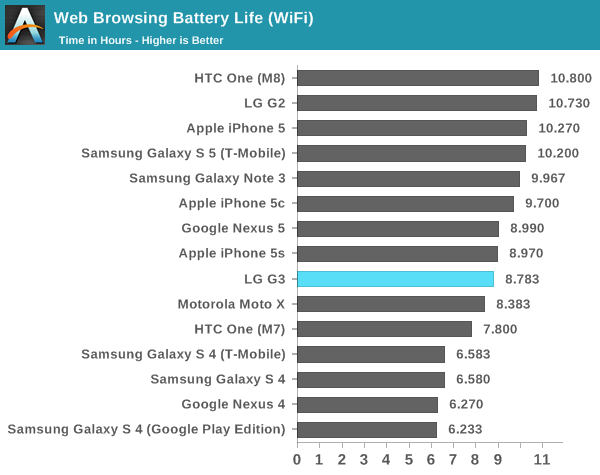
Here, the LG G3 has a major regression in battery life. While the LG G2 had around 11 hours of battery life on WiFi and was competitive with the Galaxy S5 and One (M8), the G3 is around the iPhone 5s in this test. There are a few reasons for this. If we compare battery capacity vs. display size, the LG begins at a disadvantage to HTC's One (M8). In order to equalize this gap, LG would need to fit the G3 with a 3150 mAh battery, something that would be difficult as a result of the loss in volumetric efficiency from the removable battery. The other reason is due to the lower panel efficiency, which is a direct result of the higher pixel density.
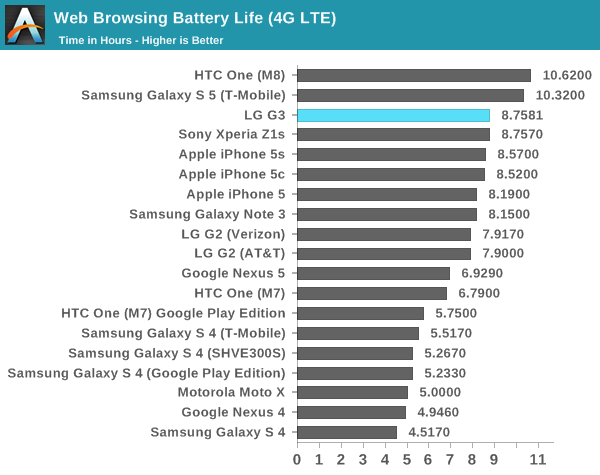
Surprisingly, in the LTE test we see a significant improvement over the LG G2, although it’s still behind the One (M8) and Galaxy S5 for the same reasons that I discussed in the WiFi test. These gains were likely made by improvements to RF and general process improvements such as envelope tracking and lower power process on the modem and other aspects of the SoC from S800 to S801.
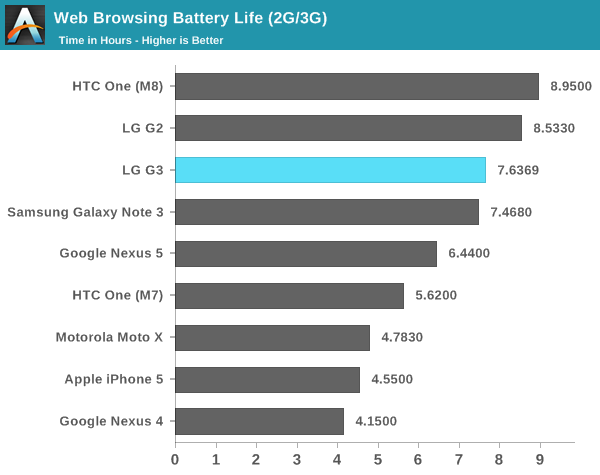
In WCDMA, there are very few surprises. As a result of bottlenecking on the network connection, battery life drops noticeably. The delta between the One (M8) and the G3 is relatively constant in this test as well, around 15-20% less in general.
Overall, the web test shows the power cost of the 1440p panel. However, in many situations the importance of display power efficiency can drop dramatically, especially if other components consume similar levels of power. To take a closer look at this, we turn to the compute-bound battery life tests. The first is GFXBench, which runs an endless loop of T-Rex on the display until the phone shuts down.
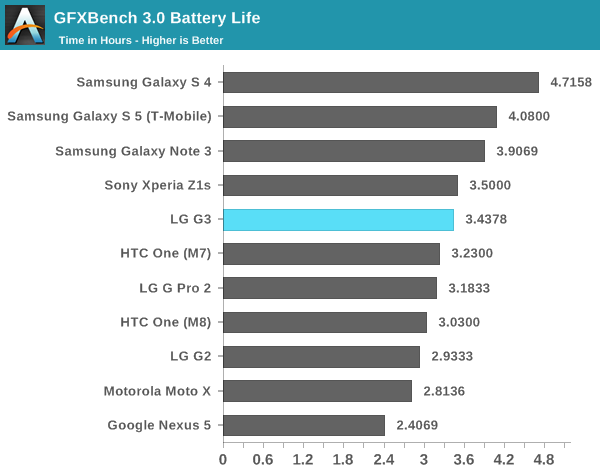
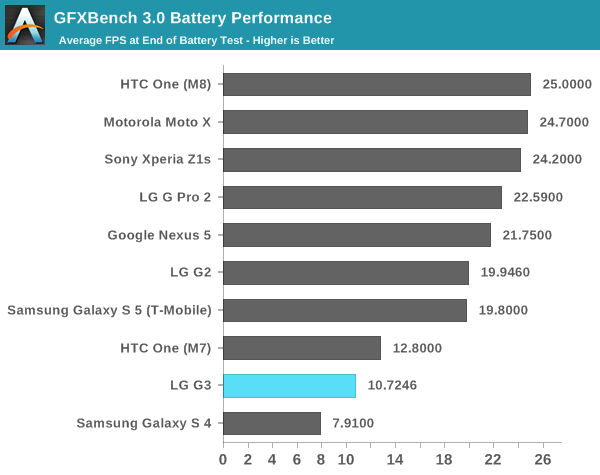
Here, we see that the LG G3 is between the One (M8) and Galaxy S5 in overall runtime. What’s surprising is that end of run FPS is below both the One (M8) and Galaxy S5, even when compensating for the difference in resolution by multiplying the score by 1.77. This actually places the LG G3 behind the G2.
However, looking at the overall picture, it’s very clear that LG is simply using a throttling mechanism that results in sinusoidal behavior. By averaging the last runs, the realistic end of run FPS is around 13.636. By scaling this to the 1080p-equivalent FPS, we see that the end of run FPS is actually around 24.1357. This means that there’s still a noticeable difference between the One (M8) and LG G3 in overall thermal dissipation capabilities, although not nearly as bad as the end of run FPS value might suggest.
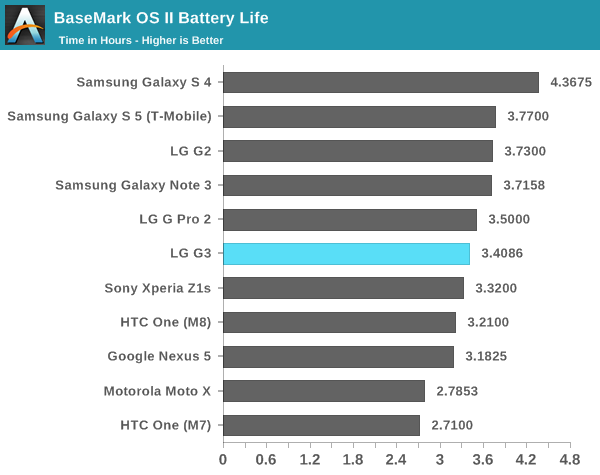
The next test is Basemark OS II, and we see that the battery life score sits between both the Galaxy S5 and One (M8), although it does worse than both of them in the battery score taking into account performance.
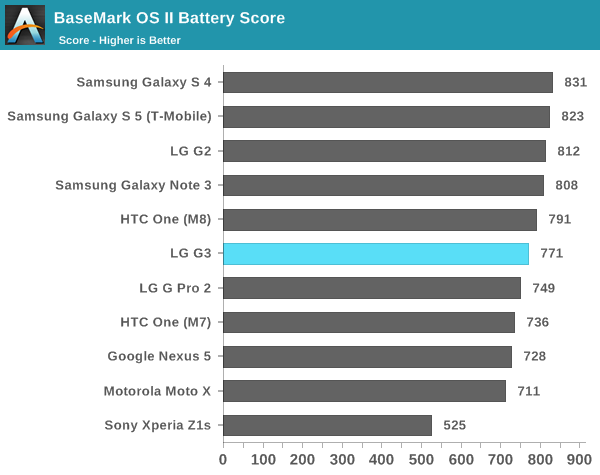
Overall, the LG G3 does acceptably well in battery life. However, after taking into account the dimming function it’s rather concerning how the G3 fails to keep up with the rest of the competition in this critical area. To really get a good idea what why this is though, we have to look at actual power numbers. This will allow us to truly quantify the power differences.
Charge Time
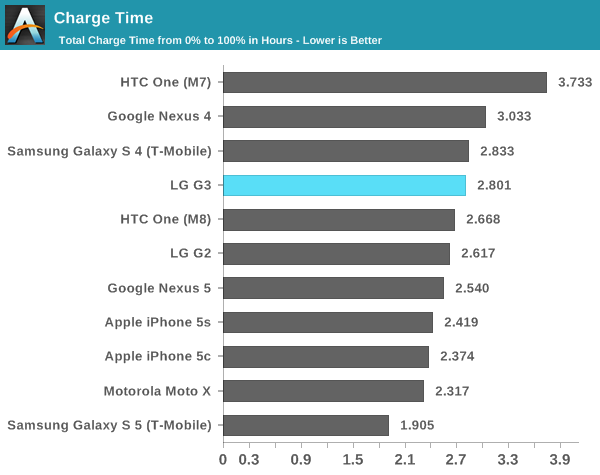
In this test, the LG G3 trails behind both the One (M8) and Galaxy S5 in charge time, although it's quite close to the One (M8). This is strange, especially because the LG G2 has the same battery size. However, this can be explained by the change to charging protocol, as it seems that the G3 doesn't support Qualcomm's Quick Charge technology. Instead, signalling is done over BC 1.2. As we'll see later in the article, this is due to the charger chip used.


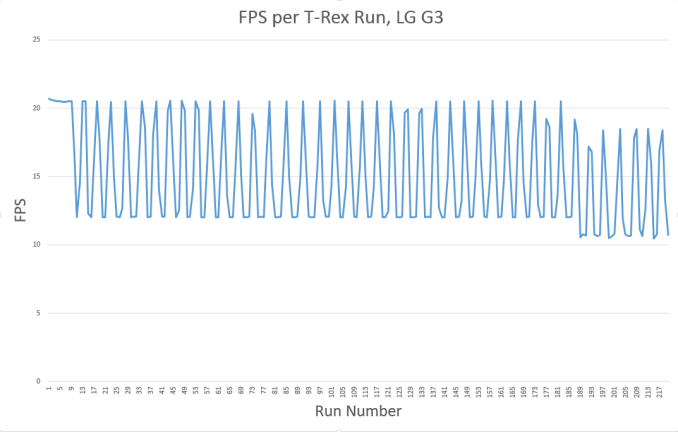








174 Comments
View All Comments
SleepyFE - Friday, July 4, 2014 - link
An Android phone works without SIM, so why does pulling it out reset it? Does the flight mode reset it as well?And you can't tell me that's a non-excuse. If you pay 200€ for a phone and you can't use it after a freeze. I would be very pissed off. A power off switch under the cover that physically cuts power would be the best way to go, but no review ever mentioned that, as far as i know.
ZeDestructor - Friday, July 4, 2014 - link
Some form of security perhaps? I just noticed it in the manual where it states that removing the SIM-card from a powered phone will cause it to reboot.If I pay any amount for a phone and it freezes unreacoverably, I would be pissed too, but like I said, there is a key you can press to power off, or you can implement some form of key combo or long-press. Be pissed at the implementation and manufacturer, not the concept.
Besides, just about the only time I've had an android phone lock up was when I overclocked or ran very early custom ROMs, something I don't do since I got a Sony phone, their ROM being so lighweight and bloat-free (admittedly after uninstalling/disabling bundled stuff like facebook) in comparison to the usual Touchwiz/Sense4 bloat
SleepyFE - Friday, July 4, 2014 - link
At the time i did not know about the factory reset button combo, but removing the battery was so easy i didn't give it a second thought (until now). Factory reset means that you have to install all the apps and change the settings. Your google account has that stored but it still takes time to download everything.ZeDestructor - Friday, July 4, 2014 - link
It doesn't do a factory reset, just a hard reboot, similar to what happens when you press the reset button on desktop computers. If it has one...What I would like on the other hand would be that the back cover would be bolted to the frame, rather than glued... means I could swap the battery when it wears out, like current lightweight laptops/ultrabooks have.
SleepyFE - Friday, July 4, 2014 - link
It did a factory reset for me on LG L5. Or maybe i pressed the wrong combo (volume up + power off). Who know anymore. I didn't have to do it since.The possible battery swap sounds perfect. Kind of like a removable battery, but only the cover holds it in place, so the phone can stay thin. Is that what you meant?
ZeDestructor - Saturday, July 5, 2014 - link
Yup. I don't mind pulling wires or carefully avoiding PCBs (And I bloody well should be, given I'm a Computer Engineering student!), and I understand why the batteries are sealed (less redundant casing), but I would like the replaceability to remain. Thus some screws holding things together looks like a good compromise to me: things can stay thin for marketing, I get my repairability, everyone is happy.ZeDestructor - Friday, July 4, 2014 - link
How do you measure up the Sony Xperia Z line? They all have strict "bands" in the phone body for different elements between the screen and the back panel: top is just enough room for a double-sided PCB containing almost all the electronics, the very bottom contains a speaker, microphone, vibrator, camera button and some antennas which leaves the middle as a large battery block, which as of right now is the biggest battery in a non-phablet phone.phoenix_rizzen - Friday, July 11, 2014 - link
Xperia Z: 2330 mAhXperia Z1: 3000 mAh
Xperia Z2: 3200 mAh
G2: 3000 mAh
G3: 3000 mAh
So, out of the complete Z line up, only 1 has a larger battery, and each of the phones is physically larger (taller and wider) with smaller screens (diagonal) than either the G2 or G3.
rxzlmn - Tuesday, July 15, 2014 - link
Well, the current one (who would care about past models?) does have the bigger battery. And the screen has the same diagonal as the G2.H20_mike - Saturday, July 5, 2014 - link
The slight increase in volumetric efficiency doesn't make up for the loss of capacity over time that all LIPO batteries suffer with enough charge cycles. As a heavy user having the option to replace the battery with a new one is a huge benefit. Also nice if buying a used and not knowing the state of the battery.